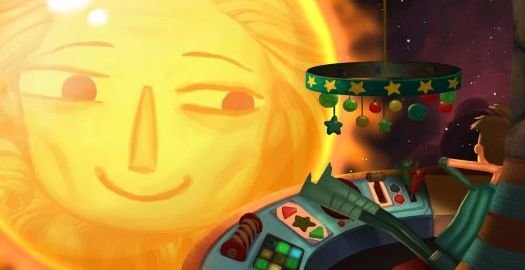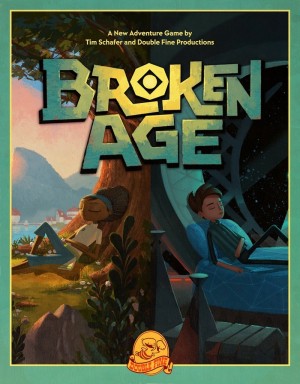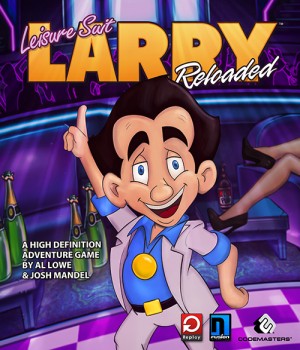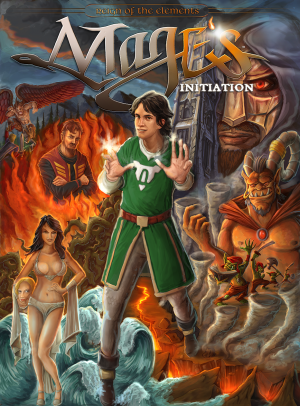Broken Age - Act 1 archived preview

Broken Age has the weight of two worlds on its shoulders. As gaming’s first multimillion dollar Kickstarter success, it embodies Tim Schafer’s longstanding dream to make a traditional adventure game in the post LucasArts era. More than 87,000 fans chipped in money to make this game a reality, and at long last the veteran designer’s first adventure since 1998’s Grim Fandango is ready for prime time… at least, the first half of the game is. Broken Age isn’t going to CHANGE EVERYTHING!!!, but for longtime fans of the genre, its launch is a significant milestone.
Then there’s the world inside the game, presented through two parallel stories about a teen boy and a teen girl with a whimsical, painted art style that evokes feelings of innocence and wonder. This world is one where a spaceship is steered with controls fashioned from a baby’s crib toy; a world where maidens dress up like frosted cupcakes in an elaborate town-wide celebration. On the surface, Broken Age appears childlike and magical, but it doesn’t take much scratching to reveal a more intricate tale beneath the fluffy facade. At the moment only the first of two acts is available, but assuming the story, gameplay, and production values continue down the path established by Act 1, we might just be looking at a modern classic.
(Double Fine has said that Act 2 will release this summer, at which time buyers will get it as a free update. If you haven’t already heard the reasons for releasing the game in two parts, you can read up on those in our recent preview. Once Act 2 is out we’ll update this article with final impressions and a score.)
Broken Age’s protagonists are Shay and Vella, two fourteen-year-olds in situations vastly different yet oddly similar. Shay lives on a spaceship where he’s grown up under the watchful “eyes” of computer programs named Mom and Dad, his only playmates a herd of annoyingly chipper, sentient stuffed animals. The entire ship has been wired to keep Shay safe; decorated with smiley faces and colorful toys, it holds Shay back in childhood like the bedroom of a teenager who hasn’t yet been given the go-ahead to redecorate. He spends his days going on missions manufactured by Mom to save his stuffed animal friends from ice cream avalanches and alien snuggle attacks, taking regular breaks to be fed nutritious meals by mechanical hands and a talking spoon. Not surprisingly, the teen has begun to rebel against this suffocating, bubble-wrapped environment, and when a snap decision to sabotage one of Mom’s missions leads to the discovery of an unknown portion of the ship, an exciting and dangerous outside world suddenly appears to be within his reach.
Vella, meanwhile, has been selected for the dubious honor of representing her baking town, Sugar Bunting, in the ritual Maidens Feast celebration. Vella is to be sacrificed to Mog Chothra, a monster who has appeared every fourteen years from beyond the Plague Dam for as long as anyone can remember, because towns that don’t offer up their tastiest maidens suffer catastrophic consequences. When Vella brings up the idea of fighting Mog Chothra instead, her suggestion is laughed off—only her feisty Grandpa Beastender takes her seriously. (He remembers the good old days when their town was populated by brave warriors… a far cry from today’s pacifist bakers.) Like Shay dutifully playing Mom’s rescue games, Vella goes along with the plan to a point. Then she breaks out of her expected trope by standing up to Mog Chothra—sweet symbolism for a video game “princess”—and her world also opens up as she embarks on a quest to save other towns in the monster’s path.
At first glance, these are two separate stories with a few parallel elements: two teenage protagonists fed up with rules imposed by authority figures; two coming-of-age journeys spawned by their rebellion. But experiencing these stories side by side reveals subtle links that you may or may not pick up depending on what order you play in and how thoroughly you explore. Though their paths don’t cross in Act 1, you can switch between Shay and Vella whenever you want. I initially played Shay’s portion, start to finish in one sitting—a choice I later regretted because it kept me from noticing moments where his story synced up with Vella’s. Upon my second playthrough, the story became richer and more complex when I alternated between the characters at each major story beat. Either way, the running time for Act 1 is 3-4 hours, and no matter how you navigate the stories I doubt you’ll see its surprise ending coming.
I stuck with Shay at first because I intended to switch to Vella when I got stuck on a puzzle… and that never happened. Not that I’m complaining: Act 1’s difficulty level was just right to keep me engaged, always thinking about what my next step would be but never too stymied to progress. Each character’s section has some degree of non-linearity, with more than one task to tackle at any point, so even when a solution wasn’t immediately obvious I was able to send my character in pursuit of a different goal (usually figuring out the puzzle that gave me pause along the way). The obstacles are traditional adventure game stuff, requiring item collection, exploration, and dialogue to overcome. In Act 1, Vella visits four distinct locations, each with a few people to talk to and goals to achieve, so her quest feels meatier than Shay’s—she’s traveling as she hunts down Mog Chothra, while he’s stuck in place trying to hack the ship’s controls and break free. But even marooned on a spaceship Shay has a variety of things to do, from inventory puzzles to a couple of simple logic challenges to a recurring arcade sequence that gets trickier each time.
As expected, Schafer’s writing is witty and wonderful. The game is peppered with great moments that happen “just because,” like rotating through Shay’s comical cereal choices or leaving his spoon babbling on the counter long enough for it to embarrass itself. On my second playthrough I heard a bunch of optional lines I missed the first time. Some players gauge a game’s humor by how often they laugh out loud, and I’ll admit that much of Broken Age’s writing is more charming than knee-slapping funny. But even if my running tally of LOLs was low, I thoroughly enjoyed the absurdity of Shay and Vella’s situations. The other maidens Vella encounters see their sacrifice to Mog Chothra as an honor, to the point of throwing their dolled-up selves at the slobbering beast—there’s something inherently wrong and uncomfortable about it, and that’s why it’s great. Same with the lanky Shay crammed into the engine car of a toy train, rolling his eyes while his stuffed animal friends scream and cower over their imminent free fall down a phony mountain. Broken Age’s situational comedy is clever and meaningful, particularly when it becomes clear that the farce is only a frosting topper on a cake made from more mature, possibly even sinister ingredients.
With crowdfunded games there’s a risk of backer involvement encroaching on the game’s design, but Broken Age isn’t full of jarring in-jokes (at least, none that I noticed). One of its best characters, however, has backers to thank. A throwaway originally conceived for an early engine test, Curtis the Lumberjack was written into the game after backers expressed their love for him—and Broken Age is better for it. Convincingly voiced by Wil Wheaton, Curtis is a paranoid slacker who fears the trees surrounding his cabin have it in for him. Knowing his origin ahead of time I feared he’d seem shoehorned in, but he's smoothly integrated into an encounter with Vella as she's on her way from one Mog Chothra pit stop to another. Curtis ended up my favorite supporting character in Act 1, responsible for some of Broken Age’s most random and refreshing humor.
In many ways, Broken Age feels like an adventure game from a bygone era, but it definitely doesn’t look like one. The unique 2D graphics make Shay and Vella’s surroundings look like paintings come alive. Some scenes are beautifully atmospheric—I especially liked Sugar Bunting’s Maidens Feast setting, with the mist skimming the water and birds flying in the distance. Others, like pretty much every room on Shay’s space ship, are sprinkled with details that are fun to see even if you can’t click on them. Certain scenes and characters are more detailed than others, as if handled by different artists whose styles don’t quite mesh, but that’s a small nitpick on art direction that’s original, imaginative, and enhances the wonder of discovery.
Broken Age’s 2D characters have heads jointed to their necks, arms jointed at their shoulders and elbows, etc. so each body part moves independently. This system allows characters quite a bit of motion without requiring that each sequence be painstakingly hand-animated. Characters’ heads turn, their bodies bob around, their shoulders shrug, their knees bend, and their arms gesture and wave, all with an effect simultaneously fluid and jerky. Faces are skillfully animated to show emotion, especially on characters like Vella with big, expressive eyes. The world is always in motion, but even so it feels intentionally flat, like its people and props have been cut out of paper and arranged with stop motion techniques over a painted backdrop. Intermittent close-up views, parallax scrolling, and cutscenes help to contribute dynamic movement and depth, but in the end it’s more like South Park than a Disney film (or Curse of Monkey Island, for that matter). For the most part I liked it, but I felt this specific visual style didn’t allow the highest-stakes moments to be amped up quite as strongly as the story deserves.
Voice acting is excellent, the standout being former hobbit Elijah Wood as Shay. It’s rare to see Hollywood talent in an adventure game, and this is one example of crowdfunding at work: Wood, a fan of adventures, was also a backer. He’s a perfect fit for Shay, his voice lilting and easy to listen to with a nice balance of adolescent cheekiness and wide-eyed excitement. Vella, voiced by Masasa Moyo, is also a character I loved listening to—her insistence that Mog Chothra must be taken down in spite of the naysaying around her is earnest and endearing. We hear these two characters the most, but they head up a talented cast that really has no bad performances. Okay, Shay’s squeaky stuffed animals did make me cringe, but that’s part of the joke.
The parallel stories are set to a great orchestral score composed by LucasArts alum Peter McConnell. The music reflects the locations and situations: from light and playful as Vella explores a village in the clouds to deep and sinister in the presence of Mog Chothra; from twinkly during Shay’s weightless space walk to suspenseful as he sneaks through the ship on his first “secret mission.” I didn’t notice until listening to the digital soundtrack afterward that certain recurring themes even give clues to how Shay and Vella’s stories intertwine.
Broken Age's controls are traditional point-and-click, nothing fancy. While I have no qualms about Double Fine’s decision not to revive SCUMM-style verbs, I do wish the smart cursor was a little dumber. Hotspots are unlabeled, and the cursor (a simple circle) doesn’t indicate what action is available, so you can never be sure until you click what you’re directing Shay or Vella to do. In Act 1 this never got me into trouble, but it can be disconcerting. Most screens have three or four hotspots to interact with—fewer than I wanted, but only because it’s easy to want more of a good thing. Broken Age is a rare game in which almost everything you try yields a unique (and often witty) response. Trying things that obviously won’t work just for the joy of hearing what Shay or Vella has to say about it is part of the fun.
The inventory, which you’ll use often, is a hidden tray at the bottom of the screen. To open it, you must first move your mouse down to that area, then hover over an arrow that appears when you’re close. It’s not difficult, but not quite intuitive. Fortunately, you can assign the opening of the inventory to any key you choose, and mapping this to my right mouse button took all the thinking out of it. To use an item, you can either click to select it, or drag it out of the inventory and into the environment.
There are eight save slots, any of which can be assigned to hold an auto-save in a process that’s not entirely clear. I managed to accidentally turn off the auto-save when starting Vella’s game, then got it working again, but the same confusing message that led me to do this could easily make you overwrite your auto-save without realizing it. You can also save manually, which I did in addition to auto-saving, quickly using up my slots. Additional slots may not technically be necessary—it’s not as if the game leads you down any dead-end paths—but people who grew up with the Sierra and LucasArts games might feel anxious without them. (I know I did!)
I experienced a few visual glitches, like a neck protruding through a character’s head or a mouth not moving while speaking, and one crash to the desktop. I’ve seen a lot worse, and these issues were rare enough that they didn’t sour my experience. (Also, I played the backer beta; Double Fine is still fixing bugs so these might not occur in the launch version.) More annoying than these little bugs was a story incongruity near the end of Vella’s portion: she knows a new character’s name even though he never properly introduces himself, and the context makes her clairvoyance particularly confusing. (I’m being purposefully vague, but you’ll know it when you see it.) If Double Fine plans to fix anything else in Act 1 at this point, this is the one issue I’d really want to see addressed.
As Shay and Vella’s stories build to exciting crescendos, Act 1 closes with a surprise that puts their parallel quests in a whole new light. It’s an awesome story twist, but the kind of cliffhanger that makes you go arrrrghhh! when the conclusion is months away. I’ll reserve final judgment until Act 2’s release this summer, but even at the halfway mark I’m confident calling Broken Age an adventure worth playing. Every aspect of it has been lovingly crafted, which might just be why it’s the best traditional adventure I’ve played in a long time. As a backer, I feel my money was well spent.













